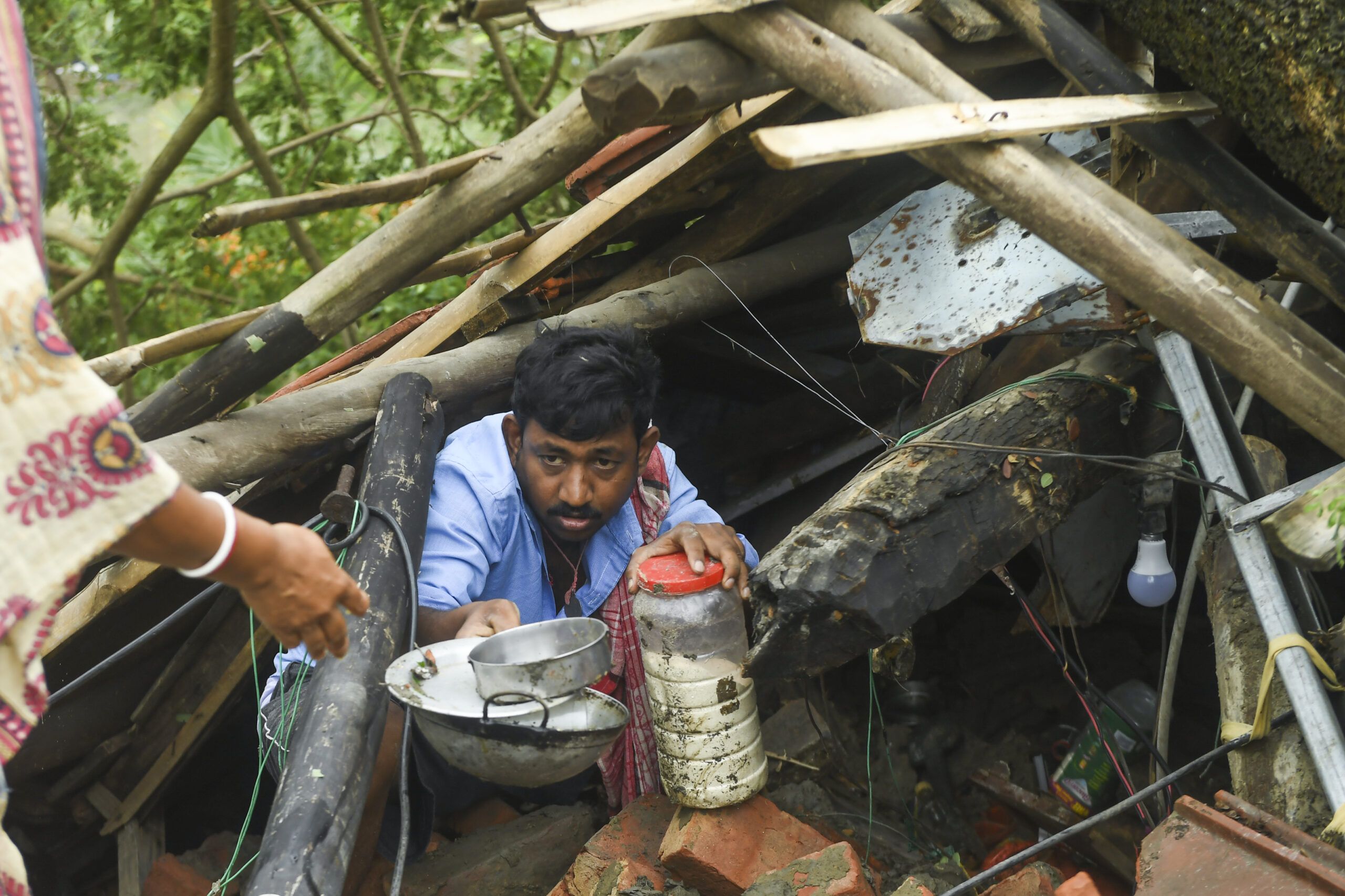Cyclone toll hits 88 as Bangladesh and India start mopping up
Villagers salvage items from their houses damaged by Cyclone Amphan in the Indian state of West Bengal (Dibyangshu SARKAR)
Satkhira (Bangladesh) (AFP) – India and Bangladesh began a massive clean-up Thursday after the fiercest cyclone since 1999 killed at least 88 people, leaving a trail of destruction in its wake.
Cyclone Amphan flattened houses, uprooted trees, blew off roofs and toppled electricity pylons, while a storm surge inundated coastal villages and wrecked shrimp farms vital to the local economy.
The United Nations office in Bangladesh estimates 10 million people were affected, and some 500,000 people may have lost their homes.
But the death toll was far lower than the many thousands killed in previous cyclones — a result of improved weather forecasting and better response plans.
The disaster has raised fears, however, that overcrowding in storm shelters will exacerbate the spread of coronavirus.
India’s West Bengal reported 72 deaths — including 15 in the capital Kolkata — with state premier Mamata Banerjee saying: “I haven’t seen a disaster of this magnitude.”
“This is the worst cyclone to hit the state since the one in 1737 when thousands lost their lives,” she told reporters.
Sixteen people have died in Bangladesh, according to the official death toll.
Improved weather forecasting meant Bangladesh was able to move some 2.4 million people into shelters or out of the storm’s direct path, while India evacuated some 650,000.
At least 10 million people were still without power on Thursday afternoon in the worst-hit districts of Bangladesh, said rural electricity board chief Moin Uddin.
The storm levelled more than 55,000 homes — most made of tin, mud and bamboo — across Bangladesh, junior disaster management minister Enamur Rahman told AFP.
Kolkata residents woke to flooded streets, with part of the city’s yellow taxi fleet up to their bonnets in water in one neighbourhood and many areas without power.
“Each second seemed like an hour,” bank manager Susanta De said of the storm.
“There were only howling winds and sounds of shattering window panes. All of it was very scary and we thought the end was nearing.”
– ‘Worse than coronavirus’ –
“The impact of Amphan is worse than coronavirus,” premier Banerjee said. “Thousands of mud huts have been levelled, trees uprooted, roads washed away and crops destroyed.”
Other officials said they were waiting for damage reports from the Sundarbans, the vast mangrove area home to endangered Bengal tigers and which bore the brunt of the storm.
The cyclone weakened as it moved north through Bangladesh but still unleashed heavy rain and fierce winds in Cox’s Bazar, the district which houses about one million Rohingya refugees from Myanmar.
The UN said the effect in the vast camps of flimsy shacks appeared to be “fairly minimal”.
The area most affected by Amphan, the first “super cyclone” to form over the Bay of Bengal since 1999, was the Satkhira district of southwest Bangladesh.
There a storm surge — a wall of ocean water often one of the main killers in major weather systems — roared inland and destroyed embankments protecting villages and shrimp farms.
In the village of Purba Durgabati, hundreds of locals worked through the night to mend a breach in a levee, but to no avail.
– Bangladesh largely spared –
“My home has gone under water. My shrimp farm is gone. I don’t know how I am going to survive,” Omar Faruq, 28, told AFP.
“The coronavirus has already taken a toll on people. Now the cyclone has made them paupers,” said local councillor Bhabotosh Kumar Mondal.
The last super cyclone in 1999 left nearly 10,000 dead in India’s Odisha state, eight years after a typhoon, tornadoes and flooding killed 139,000 in Bangladesh.
This time, as during a cyclone in Odisha last year, the human cost was greatly lessened thanks to the evacuations, said Rahman.
“Only several people died. The majority of them ventured out to collect fallen mangoes during the storm,” he told AFP.
Natural disaster expert Nayeem Wahra, at the Disaster Forum think-tank, said the storm also lost some of its potency over the Bay of Bengal before it made landfall.
“The storm surge was not powerful or high enough to cause extensive damage to lives or properties,” Wahra told AFP.
“Bangladesh was largely spared.”
Packing people into shelters, however, raised the risk of coronavirus spreading, with cases still surging in India and Bangladesh.
Authorities said they extended shelters to reduce crowding, while also insisting everyone wore face masks.
burs-stu-grk/gle
Disclaimer: Validity of the above story is for 7 Days from original date of publishing. Source: AFP.


